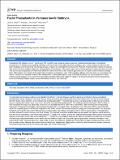Facial Transplants in Xenopus laevis Embryos
Author(s)
Jacox, Laura A.; Dickinson, Amanda J.; Sive, Hazel L.
DownloadJacox-2014-Facial transplants i.pdf (444.5Kb)
PUBLISHER_POLICY
Publisher Policy
Article is made available in accordance with the publisher's policy and may be subject to US copyright law. Please refer to the publisher's site for terms of use.
Terms of use
Metadata
Show full item recordAbstract
Craniofacial birth defects occur in 1 out of every 700 live births, but etiology is rarely known due to limited understanding of craniofacial development. To identify where signaling pathways and tissues act during patterning of the developing face, a 'face transplant' technique has been developed in embryos of the frog Xenopus laevis. A region of presumptive facial tissue (the "Extreme Anterior Domain" (EAD)) is removed from a donor embryo at tailbud stage, and transplanted to a host embryo of the same stage, from which the equivalent region has been removed. This can be used to generate a chimeric face where the host or donor tissue has a loss or gain of function in a gene, and/or includes a lineage label. After healing, the outcome of development is monitored, and indicates roles of the signaling pathway within the donor or surrounding host tissues. Xenopus is a valuable model for face development, as the facial region is large and readily accessible for micromanipulation. Many embryos can be assayed, over a short time period since development occurs rapidly. Findings in the frog are relevant to human development, since craniofacial processes appear conserved between Xenopus and mammals.
Date issued
2014-03Department
Harvard University--MIT Division of Health Sciences and Technology; Massachusetts Institute of Technology. Department of Biology; Whitehead Institute for Biomedical ResearchJournal
Journal of Visualized Experiments
Publisher
MyJoVE Corporation
Citation
Jacox, Laura A., Amanda J. Dickinson, and Hazel Sive. “Facial Transplants in Xenopus Laevis Embryos.” JoVE no. 85 (2014). © 2014 Journal of Visualized Experiments
Version: Final published version
ISSN
1940-087X